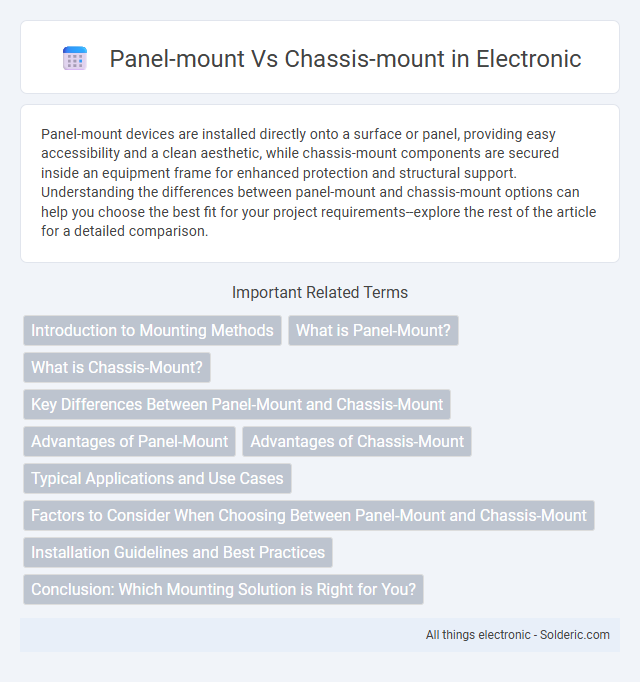Panel-mount devices are installed directly onto a surface or panel, providing easy accessibility and a clean aesthetic, while chassis-mount components are secured inside an equipment frame for enhanced protection and structural support. Understanding the differences between panel-mount and chassis-mount options can help you choose the best fit for your project requirements--explore the rest of the article for a detailed comparison.
Comparison Table
| Feature | Panel-Mount | Chassis-Mount |
|---|---|---|
| Installation Location | Mounted on the front panel or enclosure face | Mounted inside or on the frame of the chassis |
| Accessibility | Easy user access, suitable for controls and indicators | Limited accessibility, primarily for internal components |
| Application | User interfaces, switches, displays | Internal modules, circuit boards, connectors |
| Mounting Hardware | Requires bezel, screws, clips on panel surface | Bolts, screws directly securing to chassis frame |
| Space Requirements | Utilizes front panel area, minimal internal space | Utilizes internal chassis space, no front panel use |
| Protection | Often sealed for environmental resistance | Dependent on chassis enclosure for protection |
| Examples | LED indicators, toggle switches, display screens | Power supplies, internal connectors, circuit cards |
Introduction to Mounting Methods
Panel-mount and chassis-mount are two common methods for securing electronic components and devices in various applications, each offering distinct installation procedures and environmental protections. Panel-mount involves fixing components directly onto a panel surface, providing easy access and aesthetic integration, while chassis-mount secures devices within the equipment frame, ensuring robust mechanical support and protection from external factors. Understanding these mounting methods helps you choose the appropriate solution for your design needs, balancing accessibility, durability, and space efficiency.
What is Panel-Mount?
Panel-mount refers to electronic components or devices designed to be installed directly into a panel or enclosure, providing secure and accessible integration. These mounts enable easy front-facing installation, commonly used for switches, sensors, and indicators on control panels. Panel-mount components ensure durability and streamlined maintenance, making them ideal for industrial, automotive, and consumer electronics applications.
What is Chassis-Mount?
Chassis-mount refers to components or devices that are installed directly onto the frame or interior structure of an electronic or mechanical system, providing a secure and stable foundation. This mounting method is essential in applications where durability and vibration resistance are critical, such as in automotive or industrial equipment. Your choice between chassis-mount and panel-mount depends on factors like space constraints, accessibility, and environmental exposure.
Key Differences Between Panel-Mount and Chassis-Mount
Panel-mount components are designed to be installed on a panel, typically secured through cutouts, providing easy access and a clean exterior finish. Chassis-mount parts are mounted directly onto the device's chassis or frame, offering robust support but limited accessibility from the outside. The key differences lie in their installation locations, accessibility for maintenance, and the structural support they provide within electronic assemblies.
Advantages of Panel-Mount
Panel-mount components offer easier accessibility for maintenance and adjustments since they are mounted on the equipment's front panel, allowing quick operation without disassembling the entire chassis. Their installation typically provides a clean and organized appearance, improving user interface and operational efficiency. You benefit from enhanced durability and stability in environments where frequent access is required, making panel-mount solutions ideal for control panels and user interfaces.
Advantages of Chassis-Mount
Chassis-mount offers superior structural stability and ease of integration in electronic assemblies, making it ideal for heavy-duty and high-vibration environments. It provides enhanced thermal management by allowing better heat dissipation through direct contact with the metal frame, improving device reliability. Installation flexibility and simplified maintenance are achieved since components can be accessed and serviced without removing the entire panel.
Typical Applications and Use Cases
Panel-mount devices are commonly used in control panels, instrumentation, and user interfaces where easy access and visibility are crucial, such as industrial automation, audio equipment, and measurement instruments. Chassis-mount components are typically found inside electronic enclosures, providing secure mounting for circuit boards, power supplies, and cooling systems in applications like telecommunications, computing hardware, and rack-mounted servers. The choice between panel-mount and chassis-mount depends on the need for external accessibility versus internal protection and integration in electronic system design.
Factors to Consider When Choosing Between Panel-Mount and Chassis-Mount
When choosing between panel-mount and chassis-mount, consider factors such as installation environment, space constraints, and ease of access for maintenance. Panel-mount devices are ideal for front-facing controls and displays, offering convenient user interaction, while chassis-mount components are better suited for internal placement where protection and compact integration are priorities. Your selection should align with the device's intended use, durability requirements, and accessibility needs.
Installation Guidelines and Best Practices
Panel-mount installation requires precise cutouts matching device dimensions to ensure secure fitting and effective sealing against dust and moisture, while chassis-mount demands stable internal mounting points and proper clearance for ventilation and cabling. Use appropriate fastening hardware, such as screws or snap-fit mechanisms, and verify electrical grounding to prevent interference. Following manufacturer specifications for torque and alignment reduces damage risks and improves device longevity and performance.
Conclusion: Which Mounting Solution is Right for You?
Panel-mount offers a secure, flush installation ideal for user interfaces and environments requiring easy access, while chassis-mount provides versatile internal mounting suited for compact electronic assemblies and improved cooling. Choosing between panel-mount and chassis-mount depends on space constraints, accessibility needs, and equipment design priorities. Evaluate factors such as installation environment, maintenance frequency, and thermal management to determine the optimal mounting solution for your project.
Panel-mount vs Chassis-mount Infographic

 solderic.com
solderic.com